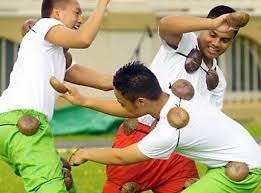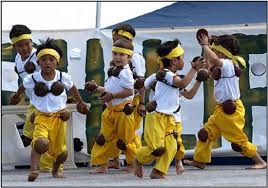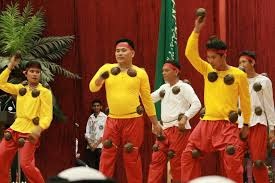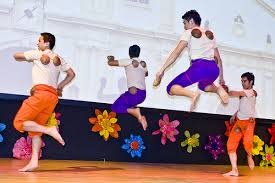
All traditional dances tell a story. The indigenous Maglalatik dance of Philippines mimics the battle between the Christian and the Muslim Moro tribesmen. Maglalatik is also called as Magbabao where ‘bao’ means ‘a coconut shell’. It is an all–male dance with coconut shells used as props. The Maglalatik embodies the element of a battle, reconciliation and a prize as well. It is usually performed during religious processions at the town fiesta of Binan. It is also a mark of obeisance to the patron saint of the town, San Isidro de Labrador. A calm and elegant display of harmless weaponry, Maglalatik is a four part war dance, which the Moro had won technically. Let us discuss Maglalatik dance in detail.
Philippines were under the Spanish rule from the 15th–18th centuries. During this period, there was a constant battle between the Christian and the Muslim Moro tribes. As the Spanish rule ended, the Filipinos began to perform a mock battle by forming two groups of Christian and the Moros. The intention was to preserve the past. Groups of men performed a war dance with no weapons but used coconut shells as props. This dance form came to be known as Maglalatik dance as the prize for winning the war was Latik. Latik is the residue obtained after boiling the coconut milk. This war dance was performed as a part of a religious procession, moving along the streets. It originated in the town of Binan in the Laguna province of the Filipino Islands and is also performed as homage to the town saint, San Isidro de Labrador.

Maglalatik is an original native dance of the Philippines in which the coconut halves are attached to the torso of the dancer. Coconut shells are tied to the hands and about 4–6 coconut shells are hung on the vest of the dancers. The dance is performed by hitting the coconut shells by one another and is tied one in the hands and one on the body. It comprises a four part scene. The palipasan and baligtaran part show intense battle whereas the paseo and escaramusa parts show the reconciliation. The dance involves simple movements, its repetition and the sound of fast drum beats.

Music accompanying the Maglalatik dance is created by the tapping of the coconut shells against each other along with the sound of fast drum beats, which fill the background.

Maglalatik dance is performed by men. Usually, red coloured trousers are worn by the Moro dancers whereas blue coloured trousers are worn by the Christian dancers. Coconut shells are attached to the chests hands, back, thighs and hips with the help of a harness.

Maglalatik dance is usually performed by men. It is an all–male dance mainly for the reason that it involves rituals of warfare, which necessitate fast and tough movements. It is a masculine type of performance where only male dancers participate. However, professional troupes sometimes, include women.



